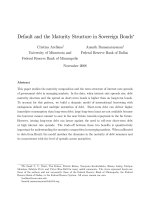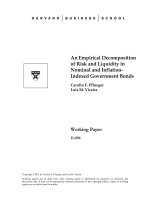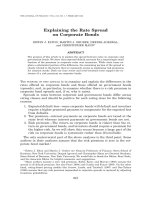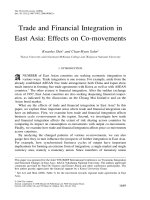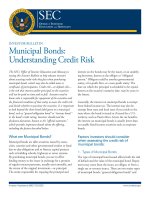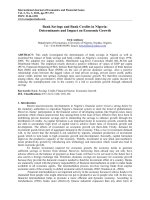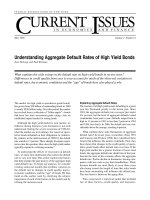Liquidity, Default, Taxes and Yields on Municipal Bonds docx
Bạn đang xem bản rút gọn của tài liệu. Xem và tải ngay bản đầy đủ của tài liệu tại đây (216.37 KB, 53 trang )
Finance and Economics Discussion Series
Divisions of Research & Statistics and Monetary Affairs
Federal Reserve Board, Washington, D.C.
Liquidity, Default, Taxes and Yields on Municipal Bonds
Junbo Wang, Chunchi Wu, and Frank Zhang
2005-35
NOTE: Staff working papers in the Finance and Economics Discussion Series (FEDS)
are preliminary materials circulated to stimulate discussion and critical comment. The
analysis and conclusions set forth are those of the authors and do not indicate
concurrence by other members of the research staff or the Board of Governors.
References in publications to the Finance and Economics Discussion Series (other than
acknowledgement) should be cleared with the author(s) to protect the tentative character
of these papers.
Liquidity, Default, Taxes and Yields on Municipal Bonds
Junbo Wang, Chunchi Wu and Frank Zhang
*
July 8, 2005
Abstract
We examine the relative yields of Treasuries and municipals using a generalized
model that includes liquidity as a state factor. Using a unique transaction dataset, we are
able to estimate the liquidity risk of municipals and its effect on bond yields. We find
that a substantial portion of the maturity spread between long- and short-maturity
municipal bonds is attributable to the liquidity premium. Controlling for the effects of
default and liquidity risk, we obtain implicit tax rates very close to the statutory tax rates
of high-income individuals and corporations, and these tax rate estimates are remarkably
stable over maturities.
*
Junbo Wang and Chunchi Wu are at Syracuse University, and Frank Zhang is at the Federal Reserve
Board in Washington DC. Address correspondence to Chunchi Wu, Whitman School of Management,
Syracuse University, Syracuse, NY 13244. Tel: 315-443-3399, fax: 315-443-5457 and email:
. An earlier version of this paper titled “Inferring Marginal Tax Rates from Green’s Model
with Default” was presented at the 2003 WFA Meeting in Cabo, Mexico. We thank Clifford Ball, John
Chalmers, Pierre Collin-Dufresne, Cheng F. Lee, Suresh Sundaresan, Walter Torous, Rossen Valkanov,
and Yuewu Xu for helpful comments. This paper represents the views of the authors and does not
necessarily represent the views of the Federal Reserve Board or members of its staff.
1
The fixed-income securities market is an important segment in the U.S. financial
markets. This market has been particularly innovative and experienced considerable
growth recently. Not surprisingly, there has been extensive literature attempting to
explain the yield spreads between different fixed income securities. A subject that has
long intrigued financial researchers is how the yield spreads between tax-exempt and
taxable securities are determined. Are default and liquidity risk priced in municipal
bonds? What portion of these spreads is attributed to taxes, default, and liquidity risk?
These issues are fundamentally important from an investment perspective due to the
sheer size of the municipal market, which now approaches 1.9 trillion dollars.
Bond returns are subject to different tax treatments. Interest on municipal bonds
is exempt from federal income taxes though not necessarily exempt from state taxes. By
contrast, interest on Treasury and government agency bonds is subject to federal income
taxes but exempt from state income taxes.
1
In equilibrium, one expects the after-tax
returns of taxable and tax-exempt bonds to be equal if both have same maturity and
comparable risk characteristics. The bond market thus provides an excellent financial
laboratory to evaluate the impact of taxation on the relative values of tax-exempt and
taxable bonds. The relative yields of taxable and municipal bonds should reflect the tax
rate of the marginal investor who is indifferent between these two bonds. Therefore, one
ought to be able to infer from the relative bond yields the implicit tax rate of the marginal
investor reasonably expected to hold these bonds.
Unfortunately, empirical evidence has not conformed very well to this expectation
but instead indicates that municipal bond yields are often higher than expected relative to
yields on U.S. Treasury bonds. This anomaly is more pronounced for long-maturity
2
bonds. The relatively high yields of municipal bonds imply a tax rate lower than
expected for the marginal tax rates of high-income individuals and corporations.
Moreover, the implied marginal tax rate is much lower for long-maturity municipal bonds
than for short-maturity bonds of similar quality and characteristics.
Several hypotheses have been advanced to explain the muni puzzle. The
institutional demand hypothesis suggests that the marginal tax rate is determined by
institutional trading activity (see Fortune, 1973; Galper and Peterson, 1971; Kimbal,
1977; Fama, 1997). Commercial banks can purchase municipals to shield their income
from taxes. An increase in their demand causes municipal yields to fall and the implicit
tax rate to rise. Since commercial banks prefer short-term bonds, the implicit tax rate
would tend to be high for these bonds relative to long-term bonds.
2
Other explanations
for the yield curve anomaly include tax-timing options (Constantinides and Ingersoll,
1984), clientele effects (Mussa and Kormendi, 1979; Kidwell and Koch, 1983), and
changes in tax regimes (Poterba, 1989).
While the arguments above have some merit, it remains unclear whether they can
fully explain the anomalous behavior of municipal yield curves. In an important paper,
Green (1993) proposes an alternative model to explain the behavior of taxable versus tax-
exempt yields. A basic argument in this model is that high-tax investors generally prefer
portfolios of taxable bonds that are tax-advantaged (or tax-efficient) to individual taxable
bonds with similar pretax cash flows. In particular, they can avoid taxes on coupon
1
Unlike Treasuries and municipals, corporate bond interest is subject to both federal and state taxes.
2
Along a similar line on institutional demand but with a different focus, Green and Odegaard (1997)
indicate that many institutions such as pension funds are either not taxed at all or have much lower taxes
than individuals. If any of these institutions invests heavily in long-term taxable bonds, the yield on long-
maturity taxables will be lower.
This will lower the yield spread between taxables and tax-exempts as well
as the implicit tax rate.
3
income by constructing portfolios of taxable bonds that generate offsetting losses or
investment interest expenses. If these investors are marginal across these portfolios and
municipals bonds, they will apply the same discount factors to the after-tax cash flows
from both positions. Using this relationship, Green obtains investors’ implicit valuation
of the pretax cash flows from par taxable bonds. By appealing to the arbitrage activities
of dealers and tax-exempt institutions, he derives an equilibrium model to explain the
relative yields of taxable versus tax-exempt bonds. The intuition behind this model is
that investors holding both taxables and municipals may not regard coupon income as
fully taxable at the margin because of the offsetting investment interest elsewhere in their
portfolios. These implicit tax benefits tend to increase with maturity, thus pulling down
the yield curve of taxable bonds at the long end.
Empirical evidence shows that Green’s model explains a considerable portion of
the relative yield differences between taxable and tax-exempt bonds (see Green, 1993).
Chalmers (1995) finds that Green’s model cannot be rejected. However, although this
model replicates the differences in curvature between the taxable and tax-exempt yield
curves reasonably well, it continues to underestimate the long-term tax-exempt yields.
3
Also, the predictive ability of the model does not hold up very well especially when there
are significant changes in statutory tax rates. While changes in tax regimes may be
blamed, these problems can also be caused by missing factors. Of particular concern is
that default and liquidity risk of municipal bonds are ignored in this model.
Municipal bonds are not risk-free and to some extent may even be riskier than
corporate bonds in the same rating class due to the unique features of municipal assets
and less predictable political processes (see Hempel, 1972; Zimmerman, 1977; and
4
Trzcinka, 1982).
4
Although municipal bonds were traditionally considered to be only
second to U.S. Treasuries in safety, defaults on municipal bonds since the late 1970s,
along with other problems, have raised concern about the credit risk of municipal bonds.
For example, of the municipal bonds issued between 1977 and 1998, 1,765 out of a total
of 253,850 issues were defaulted, with a face value of $24.9 billion out of a total of
$375.5 billion (see Litvack and Rizzo, 1999). Thus, the probability of default may not be
trivial and is of potentially greater concern for low-rated uninsured municipals.
Empirical evidence on the role of default risk is inconclusive. Several studies
(e.g., Trzcinka, 1982; Yawitz, Maloney and Ederington, 1985; Scholes and Wolfson,
1992; Kim, Ramaswamy and Sundaresan, 1993; Stock, 1994; and Liu, Wang and Wu,
2003) show that credit risk differences explain the relative yields of taxable and tax-
exempt bonds.
5
However, other studies (Gordon and Malkiel, 1981; Skelton, 1983; Ang,
Peterson and Peterson, 1985; Green, 1993; and Chalmers, 1998) find that differential
default risk cannot explain the municipal bond puzzle. A perplexing finding is that the
term structure of municipal bonds remains steeper than that of the U.S. Treasuries even
after the effect of default risk is controlled.
An important factor completely left out by previous municipal bond pricing
models is liquidity risk. The municipal market is very illiquid compared to the U.S.
Treasury bond market or the equity, futures and foreign exchange markets. Several
3
See Green (1993), p. 236.
4
Municipal assets cannot be seized as easily as corporate assets in bankruptcy proceedings because they
may be physically difficult to seize or legally protected. In addition, the incentive problem or moral hazard
is perceived to be more severe for municipalities.
5
Kim, Ramaswamy and Sundaresan (1993) provide a theoretical explanation for why default risk may
cause the term structure to have a steeper slope. They argue that credit spreads for high-quality coupon
bonds increase with maturity because longer bonds have more coupons subject to default risk. This
relationship between the credit spread and term to maturity can also explain the higher relative yields of
municipal bonds.
5
reasons have contributed to low liquidity in the municipal bond market. First, the
municipal bond market is a very thin market; many municipal bonds are traded only a
few times after issuance (see Downing and Zhang, 2004). Average weekly muni trading
volume is generally less than 12 percent of Treasury trading volume. On the other hand,
the number of muni bonds far exceeds Treasuries; well above one million different
municipal securities are issued by over 50,000 state and local governments (see Fabozzi,
1997). Thus, most individual muni bonds are traded infrequently. Second, the municipal
market is much less transparent in terms of the availability of basic information for
trading activity. Information for individual bond transactions has not been publicly
disclosed until very recently and comprehensive trade volume and price data were only
publicly available after a two-week lag.
6
Third, the municipal bond market is also less
transparent in terms of information about the bond issuers because they are not subject to
the same financial disclosure requirements as are publicly traded corporations.
7
Lack of
transparency considerably increases the information cost of trading and reduces
liquidity.
8
Although it has been long recognized that the municipal market is illiquid and
liquidity risk is a potentially important determinant of municipal yields, few studies have
provided a quantitative assessment of the size of the liquidity risk premium. A primary
reason for the lack of empirical research is that reliable transaction data for municipal
bonds were virtually non-existent until very recently. Thus, how much municipal bond
6
Beginning in January 2005, the problem of lagged release in trading information has diminished.
7
Most municipal bond issuers only release detailed financial information when they float a bond, while
publicly traded corporations are required to maintain a quarterly data feed on their activities (e.g., 10-Q and
10-K reports).
8
Harris and Piwowar (2004) report that the effective spreads in muni bonds average almost 2 percent of
price for representative retail-sized trades (20,000 dollars) while the average yield to maturity is close to 6
percent.
6
yield is attributable to liquidity risk remains unclear. In this paper, we are able to
estimate the liquidity premium of municipal bonds by using the transaction database
recently made available by the Municipal Securities Rulemaking Board. As such, this
paper represents the first empirical study of the effect of liquidity risk on the relative
municipal bond yield curve using transaction data.
The model that we propose accounts for the effects of both liquidity and default
risk on the relative yields of taxable and tax-exempt bonds. Most studies on the liquidity
effect have focused on equity markets where transaction data are easily accessible. An
exception is Harris and Piwowar (2004), which examines transaction costs and trading
volume in the U.S. municipal bond market. Unlike their studies, we focus on the
sensitivity of municipal yields (or expected returns) to liquidity risk and examine its
effect on the equilibrium pricing of municipal bonds. Specifically, we investigate the
effect of systematic liquidity risk on bond yields instead of the level of liquidity cost per
se. We construct a broad liquidity measure for the municipal market along the line of
Pastor and Stambaugh (2003), which captures temporary price fluctuations induced by
order flow. By incorporating liquidity as an additional state factor in municipal bond
yields, we find that the explanatory power of the model is greatly improved.
Our empirical results show that the liquidity risk premium accounts for a
significant portion of municipal bond yields. Results suggest that investors require a
higher yield on those municipal bonds whose returns are more sensitive to aggregate
market liquidity. Within a rating class, the sensitivity of municipal yields to market-wide
liquidity increases monotonically with maturity. At the same time, controlling for
maturity, the sensitivity of municipal yields to market-wide liquidity increases
7
monotonically as the bond rating drops from AAA to BBB. Liquidity premium explains
about 7 to 13 percent of the observed municipal yields for AAA bonds, 7 to 16 percent
for AA/A bonds and 8 to 20 percent for BBB bonds with different maturities. Ignoring
the liquidity risk effect thus results in an underestimation of municipal bond yields.
Including liquidity risk in the pricing model also helps explain the municipal yield
curve anomaly. Long-maturity municipal yields are high relative to the equivalent after-
tax yields of Treasury bonds, partly due to liquidity risk. Our results show that the
liquidity risk premium alone accounts for 65 basis points (bps) for AAA bonds, 79 bps
for AA/A bonds and 111 bps for BBB bonds with 20-year maturity. In contrast, liquidity
risk premiums are only 14 bps, 16 bps and 23 bps for 1-year AAA, AA/A and BBB
bonds, respectively. Thus, the liquidity premium accounts for a substantial portion of the
maturity spread between 20-year and 1-year bonds. Controlling for the effects of default
and liquidity risk, we obtain implicit income tax rates very close to the statutory tax rates
of high-income individuals and corporations. More importantly, these implicit tax rates
are very stable when estimated from observed yields of bonds with different maturities.
Furthermore, our liquidity premium estimates are highly correlated with
traditional liquidity variables. We find that municipal bonds with high volume and
trading frequency and larger issue size have a low liquidity risk premium. Thus, the
Pastor-Stambaugh method, which we employ to construct the aggregate liquidity of the
municipal bond market, is quite effective in abstracting the liquidity feature of the bonds.
Overall, our results show that the generalized model with liquidity risk explains the
behavior of Treasury and municipal yield curves very well.
8
The remainder of this paper is organized as follows. Section I reviews the related
literature on municipal bonds. Section II proposes a generalized municipal bond model
to incorporate the effects of default and liquidity, and discusses the empirical
methodology. Section III describes the data sample and Section IV presents empirical
results for municipal bonds of different ratings, maturities and trading characteristics.
Finally, Section V summarizes major findings and concludes the paper.
I. Related Literature
Traditional models of the yield relationship between taxable and tax-exempt
bonds assume that investors are at the margin on all bonds. They can trade freely without
any friction, and the taxation of long and short positions is completely symmetric.
Investors apply the same discount factors to the after-tax cash flows from both taxable
and tax-exempt bonds. In addition, it is assumed that municipal bonds are default-free
and priced at par, and investors hold them to maturity. Given these conditions, it follows
that the yield on the tax-exempt bond (M
t
) is simply equal to the yield on the taxable
bond (C
t
) times one minus the marginal investor’s tax rate
τ
:
)1(
τ
−=
tt
CM (1)
Miller (1977) hypothesizes that in equilibrium, corporate capital structure
decisions will force the tax rate in (1) to be the top marginal corporate tax rate. Fama
(1977) predicts that the equilibrium tax rate equals the highest marginal corporate income
tax rate because banks were able to deduct interest expenses incurred to invest in
municipal bonds from their taxable income.
Empirical evidence has shown that the implied tax rates estimated from (1) are
considerably lower than the statutory tax rates for high-income individuals and
9
corporations, particularly for long-maturity municipals. There have been attempts to
explain this anomaly. The clientele hypothesis argues that long- and short-term bond
markets may be dominated by different groups of investors. Changing tax regimes can
also incur investment risk and affect bond values, particularly for long-maturity
municipals (see Poterba, 1989). Furthermore, inferior tax-timing options on municipal
bonds may raise the relative yields especially for long maturity municipals (see
Constantinides and Ingersoll, 1984).
9
Trzcinka (1982) argues that ignoring the time-varying risk premium results in an
underestimation of the implicit marginal tax rate.
10
He suggests including a random
intercept term in the yield relationship of (1) to capture the time-varying risk premium:
ttt
CM
β
Λ
+= (2)
where
t
Λ
is the time-varying risk premium and
τ
β
−= 1 . In this model,
t
Λ
is included
to allow for the differences in default risk between tax-exempt and taxable bonds.
Yawitz, Maloney and Ederington (1985) demonstrate that if two bonds have
different probabilities of default,
β
will depend on the relative magnitudes of these
probabilities and thus cannot be interpreted as an estimate of 1-
τ
. Specifically, they show
that in equilibrium the following yield relationship holds:
tttt
CM
β
α
+= (3)
where
),1(
1
g
t
t
t
τ
λ
λ
α
−
−
=
and
t
t
λ
τ
β
−
−
=
1
1
,
t
λ
is the default probability at time t,
τ
is the
ordinary income tax rate and
g
τ
is the capital gain (or loss) tax rate.
11
9
An investor purchasing a taxable bond at a premium can amortize the premium against interest income
over the remaining life of the bond. By contrast, the premium on a tax-exempt bond cannot be so
amortized. In addition, capital gains from selling municipal bonds are subject to federal taxes.
10
Green (1993) proposes a different model that considers investors’ ability to shield
coupon income from taxation. Taxable investors may form a tax-advantaged portfolio to
avoid taxes on the cash flows received before maturity by the following trading strategy.
Suppose there is a par bond with coupon rate
C and maturity date T and another par bond
with coupon rate
C/2 and the same maturity date but traded at a discount. A long position
with two
C/2 coupon bonds and a short with one C coupon bond will result in no coupon
income and hence, no net tax liability prior to maturity. This strategy can be applied to
any bonds with different coupons to form a tax-advantaged portfolio. While individual
investors may be precluded from holding this type of tax-advantaged portfolio due to
limitations on interest deductions from borrowings and short positions, bond dealers are
not. Therefore, from a dealer’s point of view, cash flows from par bonds and a sequence
of pure principal payments are equivalent. Any difference in price between a pair of
bonds or bond portfolios with identical income streams creates an arbitrage opportunity
for dealers.
Specifically, to the investor who pursues the above strategy to generate net zero
coupon payments, the after-tax cash flow of the position is )1(1
t
P−−
τ
where
t
P is the
cost of the position at time
t, which is equal to the total price of two C/2 coupon bonds
minus the price (=1) of one
C coupon bond assumed equal to par. The price
t
P of this
position must then be equal to the discounted after-tax value of its cash flow:
ttt
dPP )]1(1[ −−=
τ
(4)
where
t
d is the after-tax discount factor. Solving for
t
P yields
10
A similar argument is made by Wu and Yu (1996) in a different context.
11
Wu (1991) extends Yawitz et al. (1985) to consider investors’ risk-averse behavior and finds that the
slope coefficient further depends on risk premium.
11
t
t
t
d
d
P
τ
τ
−
−
=
1
)1(
(5)
From the dealer’s viewpoint, cash flows from par bonds with maturity
T and a
sequence of pure principal payments are equivalent and so they should have the same
price; that is,
∑
+=
=
T
t
TtT
PPC
1
1 (6)
Substituting
t
P in (5) into (6) gives
T
T
t
t
T
t
T
d
d
d
d
C
τ
τ
τ
τ
−
−
+
−
−
∑
=
=
1
)1(
1
)1(
1
1
(7)
At the same time, the value of a par municipal bond with equal maturity will be equal to
∑
+=
=
T
t
TtT
ddM
1
1 (8)
Combining (7) and (8), one can obtain the following equilibrium relationship
between the yield curves of municipals and Treasuries:
12
()
∑
−
∑
−
−=
=
=
T
t
T
t
T
t
t
t
TT
d
d
d
d
CM
1
1
1
1
1
τ
τ
τ
(9)
where
))1(1(
t
t
t
P
P
d
−−
=
τ
is the after-tax discount factor for the cash flow at time t, and
t
P is the pretax discount factor of a zero-coupon default-free taxable bond. The model
implies that the ratio of the tax-exempt yield to the taxable yield, M
T
/C
T
, increases with
maturity. When maturity
T = 1, the ratio multiplying the after-tax coupon on the right
side of (9) is equal to one, and 1 – M
T
/C
T
gives the tax rate of the marginal investor. For
12
longer maturities, the ratio multiplying the after-tax coupon is greater than one if forward
rates are positive (
d
T
< d
t
for t < T). The longer the maturity, the larger this ratio, making
M
T
increasingly large relative to C
T
. Thus, if one uses the formula 1- M
T
/C
T
to obtain the
implicit tax rate from the yields of taxable and tax-exempt bonds, the resulting estimate
will be biased downward.
While Green’s (1993) model is quite appealing, it does not consider the effects of
liquidity and credit risk. Unlike Treasury securities, municipal bonds are subject to
default. In addition, compared to the Treasury market, the municipal market is very
illiquid. These two factors can complicate the equilibrium yield relationship. Liu, Wang
and Wu (2003) consider the effect of default risk on municipal yields. They argue that
ignoring default risk may result in a biased estimation of the implicit marginal income tax
rate for long-maturity bonds. However, several studies have shown that for default risk
to explain the muni yield puzzle, the implied default probabilities for municipals would
have to be unreasonably large (see, for example, Poterba, 1986; Jordon and Jordan, 1990;
and Green, 1993). Chalmers (1998) uses a large sample of municipals over an extended
sample period to examine the issue and finds that default risk cannot explain the muni
yield puzzle. Thus, default risk alone does not appear to be able to provide the answer to
the empirical puzzle.
In this paper, we explore the role of liquidity risk in municipal bond pricing. We
take advantage of a unique transaction dataset recently made available by the Municipal
Securities Rulemaking Board to estimate the liquidity risk of municipals and examine its
effect on bond yields. To the extent that illiquidity can significantly affects the municipal
bond yields, analyzing the effect of liquidity risk should shed light on the muni puzzle.
12
See Green (1993) for the details of derivation.
13
In the following section, we propose a generalized municipal bond model with default
and liquidity risk and discuss the empirical estimation procedure.
II. A Generalized Municipal Bond Pricing Model
A. The Model
Following Green (1993), we assume that municipal and Treasury bonds are priced
at par and both are noncallable. In addition, investors pursue a buy-and-hold strategy.
However, unlike his model, municipal bonds are subject to default. The probability of
default at time
t is
t
λ
and the recovery rate is
δ
when default occurs.
13
When there is no default, the present value of the payoff for the municipal bond is
()
∏
−
⎟
⎠
⎞
⎜
⎝
⎛
∑
+
=
=
T
t
t
T
t
TtT
ddM
1
1
1
λ
(10)
Conversely, when default occurs, the bond investor receives a residual (recovery) amount
δ
. The present value of the expected cash flow of the municipal bond if default occurs at
time
i, is given by
()
∏
−
⎟
⎠
⎞
⎜
⎝
⎛
+
∑
−
=
−
=
1
1
1
1
1
i
k
ki
i
t
tT
dM
λλδ
(11)
where
δ
is expressed in terms of present value. The value of the municipal bond at time t
is equal to the sum of (10) and (11). Because we assume that the municipal bond is
priced at par, the pricing formula can be written as
() ( )
∑
⎥
⎦
⎤
⎢
⎣
⎡
∏
−
⎟
⎠
⎞
⎜
⎝
⎛
+
∑
+
∏
−
⎟
⎠
⎞
⎜
⎝
⎛
∑
+=
=
−
=
−
=
=
=
T
i
i
k
ki
i
t
tT
T
t
t
T
t
TtT
dMddM
1
1
1
1
1
1
1
111
λλδλ
(12)
Combining the pricing formula for Treasuries in (7) with (12), we obtain the following
equilibrium relationship between municipal and Treasury yields:
13
The recovery rate is formulated as a fraction of the face value.
14
()
() ( )
() ( )
⎭
⎬
⎫
⎩
⎨
⎧
∑
⎥
⎦
⎤
⎢
⎣
⎡
∏
−
⎟
⎠
⎞
⎜
⎝
⎛
∑
+
∏
−
∑
−
−
∑
⎥
⎦
⎤
⎢
⎣
⎡
∏
−−
⎥
⎦
⎤
⎢
⎣
⎡
∏
−−
+
∑
−
−
=
=
−
=
−
=
=
=
=
−
==
=
T
i
i
k
ki
i
t
t
T
t
t
T
t
t
T
T
T
i
i
k
ki
T
t
tT
T
t
t
t
T
T
dd
d
d
d
d
d
C
M
1
1
1
1
1
1
1
1
1
11
1
11
1
1
1
111
1
1
λλλ
τ
τ
λλδλ
τ
τ
(13)
The pricing formula above is not complete because it does not include the effect
of liquidity risk, which is considered to be a critical factor for municipal bond pricing.
Liquidity is perceived as an important feature of the investment environment. Previous
studies have shown that the level of liquidity affects expected asset returns (see, for
example, Amihud and Mendelson, 1986, 1991; Brennan and Subrahmanyam, 1996;
Brennan, Chordia and Subrahmanyam, 1998; and Amihud, 2002). That the level of
liquidity can affect transaction cost and asset price is not surprising. What is more
important is whether liquidity risk is a systematic risk that affects equilibrium asset
returns. In an influential paper, Pastor and Stambaugh (2003) show that expected stock
returns are significantly affected by systematic liquidity risk. They suggest that it should
be fruitful to examine the liquidity in the bond market and its impact on pricing, since the
effect of liquidity risk on bond returns can potentially be quite different from that on
stock returns.
14
To account for the effect of liquidity risk, we add a liquidity risk variable to (13)
and rewrite it in a more compact form:
LCM
LtTTT
β
β
Λ
++= (14)
14
Recent studies in fixed-income markets have found that traditional term structure models of defaultable
bonds explain only a small portion of yield spreads (see, for example, Huang and Huang, 2003). A
potential cause is that liquidity risk is not accounted for by these models. Longstaff, Mithal and Neis
(2005) find that the liquidity premium accounts for a significant portion of corporate bond spreads. Since
15
where
() ( )
() ( )
⎭
⎬
⎫
⎩
⎨
⎧
∑
⎥
⎦
⎤
⎢
⎣
⎡
∏
−
⎟
⎠
⎞
⎜
⎝
⎛
∑
+
∏
−
∑
−
−
∑
⎥
⎦
⎤
⎢
⎣
⎡
∏
−−
⎥
⎦
⎤
⎢
⎣
⎡
∏
−−
=
=
−
=
−
=
=
=
=
−
==
T
i
i
k
ki
i
t
t
T
t
t
T
t
t
T
T
T
i
i
k
ki
T
t
tT
T
dd
d
d
d
1
1
1
1
1
1
1
1
1
11
11
1
1
1
111
λλλ
τ
τ
λλδλ
Λ
and
()
() ( )
⎭
⎬
⎫
⎩
⎨
⎧
∑
⎥
⎦
⎤
⎢
⎣
⎡
∏
−
⎟
⎠
⎞
⎜
⎝
⎛
∑
+
∏
−
∑
−
∑
−
−
=
=
−
=
−
=
=
=
=
T
i
i
k
ki
i
t
t
T
t
t
T
t
t
T
T
t
t
t
T
dd
d
d
d
1
1
1
1
1
1
1
1
11
1
1
1
1
λλλ
τ
τ
τ
β
L
β
is the sensitivity of the yield of an individual municipal bond or portfolio to the
aggregate liquidity L of the municipal market. Equation (14) states that in equilibrium
the municipal bond yield equals the adjusted Treasury bond yield (the first two terms on
the right hand side adjusted for tax and default effects) plus a systematic liquidity risk
premium, which compensates for the low liquidity of municipal bonds relative to
Treasuries of equal maturity. This yield model can be applied to municipal bonds of any
rating and maturity by allowing default and liquidity risk to vary.
Standard asset pricing theory suggests that expected security returns are related to
returns’ sensitivities to state factors. If liquidity is one of these state factors, investors
will require higher expected returns on securities that are more sensitive to aggregate
market liquidity. This theoretical argument holds not only for equities but also for fixed-
income securities in general. Thus, municipal securities should be no exception. If
municipals are less liquid than Treasury securities, investors should demand higher yields
the municipal market is very illiquid by conventional standards, liquidity risk could also be very important
for pricing municipal bonds.
16
(or expected returns) from holding municipals to compensate for this risk. Likewise, in
the domain of municipal securities, those municipals whose returns have higher
sensitivities (
L
β
) to aggregate market liquidity should offer higher yields than other
municipals with lower sensitivities.
Intuitively, the role of liquidity in securities pricing would depend on the
importance of liquidity for a specific investment and the liquidity condition of a market
relative to others. Since the municipal market is relatively illiquid compared to other
markets, liquidity risk would likely be an important pricing factor for municipal bonds.
When there is a widespread deterioration in liquidity, it will be more difficult to liquidate
municipal bonds than Treasuries securities. In anticipation of costly liquidation in a low
liquidity environment, investors will require higher yields to compensate for this risk
regardless of the tax-exempt advantage of municipals. Furthermore, the trade size of
municipals is typically larger than that of equity transactions. Liquidity is expected to be
more valuable for investors trading large orders than small orders even in routine
transactions. In an unusual situation when the aggregate market liquidity dries up, it will
be much more difficult to trade large quantities. Taken together, liquidity risk should be
more serious concern for municipal investors and if so, this would have a significant
implication for municipal bond pricing.
15
The relevance of liquidity risk to municipal bond pricing is measured by the
sensitivity coefficient
L
β
to the aggregate liquidity of the municipal bond market.
Similar to the risk measure in traditional asset pricing models,
L
β
captures the systematic
15
The importance of liquidity is well spelled out by the recent event associated with the reduction in
personal taxes on regular income and dividends by the Bush Administration. The event triggered a sell-off
17
risk (liquidity beta) of individual municipal bonds to the market-wide liquidity. We use
the aggregate liquidity measure of the municipal market itself to estimate liquidity beta
for the following reasons. First, since an individual financial market typically exhibits
commonality in liquidity, it justifies the estimation of systematic liquidity risk of a
municipal bond by its co-variation with the liquidity innovations of the overall municipal
market. The rationale is that those municipal securities whose returns are more exposed
to market-wide liquidity fluctuations should have higher yields (expected returns).
Second, the Treasury yield (C
t
) on the right hand side of the model in (14) has impounded
the effect of the Treasury liquidity risk and so there is no need to add the liquidity
innovations of the Treasury market as an additional explanatory variable in the municipal
yield model.
To estimate liquidity risk
L
β
, we need to construct a market-wide liquidity
measure (L) for municipal bonds. In the following, we outline the procedure for
constructing a measure of aggregate liquidity for the municipal bond market in the spirit
of Pastor and Stambaugh (2003).
The proposed aggregate liquidity measure captures temporary price changes
associated with order flow. The fundamental argument is that lower liquidity tends to
correspond to stronger price reversals on the next trading day, resulting from the order
flow in a given direction on a particular day. For example, in the absence of private
information, a large number of sell orders (or a high sell volume) on a particular day will
cause a greater price rebound on the next trading day. This dimension of liquidity can be
gauged by the response of municipal returns in the next trading day to the signed volume
in the municipal market as the tax-advantage of municipals was eroded. Because liquidity was low, the
sell-off had a tremendous impact on municipal bond prices across the board.
18
in the preceding trading day. Specifically, the liquidity measure for a bond in a month t
is the least squares estimate of the parameter
t,i
π
associated with the signed volume in
the following regression:
16
tjitji
e
tjititji
e
tji
uVolrsignrr
,1,,,,,,,,10,1,
)(
++
+⋅++=
πρρ
(15)
where
tjbtji
e
tji
rrr
,,,,,,
−= is the return of municipal bond i on day j,
tji
r
,,
, in excess of the
equally weighted municipal market return,
tjb
r
,,
; )(
,,
e
tji
rsign is the signed indicator which
is equal to 1 if
e
tji
r
,,
is positive, and -1 if it is negative; and
t,j,i
Vol is the dollar volume (in
ten-thousand dollars) for bond
i.
17
In this model, the order flow is measured by volume
signed by the contemporaneous excess return on a particular municipal security. The
order flow is expected to be followed by a return reversal if the municipal security is not
perfectly liquid. Presumably, the greater the expected reversal for a given dollar volume,
the lower the liquidity of the municipal security; that is,
t,i
π
is negative. The model in
(15) is estimated for individual bonds each month
t using daily return and volume data.
In empirical investigation, in order to obtain a reliable estimate of
π
, we select in each
month only those bonds which have more than 10 observations.
The liquidity measure of each individual bond is then aggregated over all
municipal bonds (
N) in the sample month by month:
∑
=
=
N
1i
t,it
N
1
ˆ
ππ
(16)
Systematic liquidity risk,
L
β
, is measured as the sensitivity of bond returns to unexpected
innovations in market-wide liquidity. To obtain the unexpected liquidity innovations
16
For the detail of the derivation, see Pastor and Stambaugh (2003).
19
(
t
e
ˆ
), we estimate the following autoregressive model for the differenced liquidity
measure:
t1t21t10t
e
ˆ
a
ˆ
aa
ˆ
+++=
−−
π
π
∆
π
∆
(17)
The above regression is essentially a second-order autoregression in the level series of
market-wide liquidity.
18
Since the residual term for municipal bond liquidity is typically
quite small, we multiply the estimated
t
e
ˆ
by 100:
tt
eL
ˆ
100
⋅= (18)
After constructing the market-wide liquidity measure, we include it as a state factor for
the municipal bond yield model to estimate the liquidity risk premium of municipal
bonds.
B. Estimation Procedure
The municipal yield model in (14) can be estimated by the nonlinear regression
method. Since municipal bond yields are serially correlated, we correct the effect of
autocorrelation. The first step in empirical investigation is to abstract the liquidity
measure from (15) and (17). The model in (15) is particularly suitable for our
investigation of municipal market liquidity because it requires only the excess return and
dollar volume data. These data are readily available from the transaction records
provided by Municipal Securities Rulemaking Board (MSRB). As noted, to construct a
meaningful liquidity index, we impose the restriction of a minimal number of 10
transactions each month for an individual municipal security. Although municipals are
traded less frequently, this presents little difficulty because the MSRB database contains
17
Pastor and Stambaugh (2003) find that this specification works better than other specifications with
excess lagged returns.
18
Pastor and Stambaugh (2003) show that this time-series model captures liquidity innovations rather well.
20
records for more than one million municipal securities. This large database grants us a
considerable leeway to choose a suitable sample to estimate market-wide liquidity. After
imposing the constraint of the minimal number of transactions per month, we still have
149,666 bonds that meet this criterion. This sample size is large enough to represent the
overall municipal market. Note that this particular sample is selected mainly for
estimation of the market-wide liquidity factor. For the estimation of the municipal yield
model in (14), we impose different criteria to better control the data sample as explained
later in the data section.
In the second step, we form the portfolios of muni bonds by rating and maturity.
There are advantages of estimating the yield model with portfolios. First, forming
portfolios allows us to construct more regular time series of municipal yields for
regression estimation, to overcome the problem of infrequent trading. Second, portfolio
formation reduces data noise associated with individual bonds due to recording errors and
stale prices. Because the portfolios are grouped by rating and maturity, we retain control
on these two important bond characteristics. We calculate the yield for each portfolio
from our data sample month by month. We then estimate the nonlinear model in (14)
using monthly yield data of each portfolio using the Gauss-Newton method.
III. Data Description
We use the municipal bond database provided by the Municipal Securities
Rulemaking Board in our empirical estimation. The MSRB is the self-regulatory agency
established by Congress, which develops rules subject to SEC approval to govern the
conduct of brokers and dealers involved in underwriting and trading municipal securities.
Approximately 2,700 municipal securities brokers and dealers are registered with the
21
MSRB. Since 1997, the municipal bond industry has operated under a mandatory
transaction reporting system overseen by the MSRB. All dealer-to-dealer and dealer-to-
customer muni bond transactions are reported to the MSRB after the close of business
each day. The MSRB then consolidates the daily reports. Beginning in July 2000, the
MSRB started releasing electronic files containing all municipal bond transaction data
two weeks after actual transactions took place.
19
The MSRB transaction reports contain
data fields including CUSIP, security description, issue date, coupon, maturity date, trade
date, time of trade, par amount of trade, transaction price, and yield. Useful features of
the data include whether a transaction is sale to customer, purchase from customer or
inter-dealer trade, and an indicator showing whether the trade occurs before the syndicate
settlement date.
Additional information on the characteristics of each bond are collected from
Bloomberg, which includes the rating of a bond when it was issued, the issue size and
type (e.g., general obligation or revenue bonds), whether the bond is callable or contains
a sinking fund provision, and whether the bond is insured. Zero-coupon Treasury yields
are obtained from the Federal Reserve Board (FRB), where spot rates are estimated from
Treasury prices using the Svensson method (see Bolder and Streliski, 1999, for details).
The sample period is from July 2000 to June 2004. The initial sample contains a
total of 1,056,774 bonds, 27,330,633 transactions and dollar volume of 11.7 trillion. A
notable feature of the municipal market is that most bonds are not frequently traded.
Compared to the Treasury market, the trading volume on the municipal bond market is
19
The initial lag was one month, but the MSRB has since sequentially reduced the lag time to two weeks,
one week and one day. Beginning January, 2005, the lag was substantially reduced as the MSRB and the
Bond Market Association (BMA) partnered to make transaction data available within fifteen minutes of a
trade.
22
much smaller. For example, in June 2004, the average weekly volume (total par value
traded) on the municipal market is 89.68 billion, while the average weekly Treasury
transaction is 756.21 billion, according to New York Fed’s weekly survey on primary
Treasury dealers conducted each Wednesday. Infrequent trading is a key factor
contributing to low liquidity in this market.
To construct the data sample for our empirical estimation of the municipal yield
model in (14), we match the raw MSRB data with bond characteristic information from
Bloomberg and impose the following screening criteria.
20
We first drop trades that occur
on or before the underwriting syndicate settlement date, and keep only secondary market
trades. This filter reduces the number of bonds to 805,510 and the number of transactions
to 22,967,938. We then eliminate bonds with unknown credit ratings, leaving 686,859
bonds and 21,554,555 trades in the sample. Since our municipal model holds for straight
bonds, we delete bonds with embedded option features (i.e., bonds with call and sinking
fund provisions). Due to the fact that the majority of municipal bonds are callable, this
filter decreases the sample substantially to 114,626 bonds and 2,149,008 trades. We also
eliminate bonds that carry variable rates or irregular coupons. This restriction removes
185 bonds and 2,500 transactions. To focus on bonds that are relatively frequently traded
in order to construct the portfolios with enough observations, we keep only those
transactions that are within one year from the issuance date. This step excludes 61,371
bonds and leaves 53,070 bonds and 883,753 transactions in the sample. In addition, we
throw away transactions with obvious errors in prices or with missing prices. This filter
drops 207 bonds and 7,541 trades. Finally, for a similar concern about liquidity, we
23
exclude those bonds that are less than six months away from maturity. Our final sample
contains 48,278 bonds with a total of 753,268 secondary market transactions.
We group the individual bond data according to their ratings and maturities.
Because there are very few speculative bonds in our data sample, we include only bonds
in the following rating classes: AAA, AA/A and BBB. In the original database, AA and
A bonds are grouped together and so we keep them in one group. There are very few
trade and transaction price data for bonds with long maturity. We therefore lump
(equally weighted) all bonds with maturities from 18 to 22 years to form long-term
portfolios. This enables us to assemble a larger number of observations in portfolios to
examine the empirical properties of long-term municipals. The average maturity for these
long-term portfolios is very close to 20 years: 19.9 years for AAA, 19.5 years for AA/A
and 19.9 years for BBB bonds.
21
For convenience, these portfolios are placed under the
20-year category for the corresponding rating class.
Table I provides the summary statistics for the three rating groups of municipals,
and Treasuries by maturity. Panel A shows that yields of AAA bonds are lower than
those of AA/A bonds which, in turn, are lower than those of BBB bonds. Yields of
Treasury bonds with the same maturity are generally greater than those of AAA and
AA/A bonds. However, Treasury yields may be lower than BBB yields, indicating that
the default and liquidity premia may outweigh the tax-exempt advantage for bonds in this
rating class. Figure 1 plots the time-series of municipal and Treasury yields for
maturities from one to ten years.
20
As noted earlier, this sample selection procedure applies to our yield model estimation. For the
construction of the liquidity index, we impose a less stringent restriction that only requires a minimum of
10 transactions per month for each individual bond.

